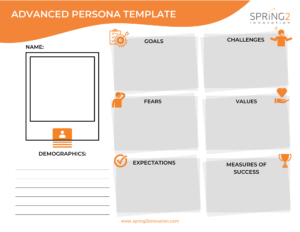Design thinking is a user-centred approach to innovation and problem solving. The foundational step in design thinking is first empathizing with users, which involves researching the people for who you are designing your products, policies, and services.
How do designers know who exactly they are designing for? Let’s look at one of the most invaluable tools inside a Design Thinker’s toolkit – personas.
What exactly is a persona?
A persona is a fictional profile of a specific user group that contains information like:
- Demographic information – age, income, education level, or employment status
- Their needs, goals, and challenges while using the product or service
- Their behaviours, motivations, and measures of success
- Their thoughts and expectations
While not essential, some designers will include the following to illustrate their persona fully:
- A name
- A photo or illustration of the fictional persona
- A quote that expresses the user’s needs or goals
 There are many different persona templates out there that you can use, and you can be as detailed as you like. Just remember that it is essential to have the core key information – goals, challenges, values, fears, and expectations – included in the persona.
There are many different persona templates out there that you can use, and you can be as detailed as you like. Just remember that it is essential to have the core key information – goals, challenges, values, fears, and expectations – included in the persona.
There may be variations in how you request the information for your personas. It’s essential to ensure you develop personas with actual end-users. You may find that you have made some assumptions that need to be challenged or validated by your users themselves. If working with users is not an option, consider getting feedback from your team, members of your organization, or consulting other stakeholders involved with the product or service you are designing.
Develop Multiple Personas
You will most likely need to create between 3 and 8 personas based on how the user groups behave. The number of personas you develop depends on your particular product or service.
Designers leverage personas to recognize the different needs and behaviours between their user groups. They are also used to identify patterns within their user research. Other segments of users may have a different experience with a product or service. Multiple personas are useful for parsing out these differences within your user groups. Multiple personas are helpful in parsing out these differences within your user groups and ensuring you are always designing for your users’ real needs.
Good designers (and their teams) make an effort to connect with their personas and make them real – and are more likely to consider them during the design process.
Wrapping Up
Personas put your end-users front and center for the design process’s duration, ensuring their needs are addressed during the creation of the product or service. Personas are useful because they can be referenced during any design thinking phase to ensure you are following a human-centric design process.
When in doubt – refer back to your personas and ask yourself questions like:
- How will this decision affect my persona?
- Would my persona be happy if we did/changed this?
Personas work best in conjunction with other empathizing tools, like empathy maps and journey maps, to truly understand and empathize with end-users.
As part of Spring2 Innovation’s Design Thinking Certificate, we teach you how to master all five phases of the Design Thinking methodology, starting with Empathize. We teach learners how to create effective personas and conduct other types of user research needed before beginning a new design (or re-design) of a product or service that involves end-users.
To learn more about Design Thinking or to become Design Thinking Certified with Spring2 Innovation, please contact training@spring2innovation.com.

